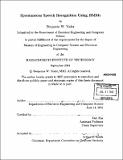| dc.contributor.advisor | Deb Roy. | en_US |
| dc.contributor.author | Yoder, Benjamin W. (Benjamin Wesley), 1977- | en_US |
| dc.contributor.other | Massachusetts Institute of Technology. Dept. of Electrical Engineering and Computer Science. | en_US |
| dc.date.accessioned | 2007-02-21T11:25:34Z | |
| dc.date.available | 2007-02-21T11:25:34Z | |
| dc.date.copyright | 2001 | en_US |
| dc.date.issued | 2003 | en_US |
| dc.identifier.uri | http://hdl.handle.net/1721.1/36108 | |
| dc.description | Thesis (M.Eng.)--Massachusetts Institute of Technology, Dept. of Electrical Engineering and Computer Science, February 2003. | en_US |
| dc.description | Includes bibliographical references (leaf 63). | en_US |
| dc.description.abstract | This thesis describes a speech recognition system that was built to support spontaneous speech understanding. The system is composed of (1) a front end acoustic analyzer which computes Mel-frequency cepstral coefficients, (2) acoustic models of context-dependent phonemes (triphones), (3) a back-off bigram statistical language model, and (4) a beam search decoder based on the Viterbi algorithm. The contextdependent acoustic models resulted in 67.9% phoneme recognition accuracy on the standard TIMIT speech database. Spontaneous speech was collected using a "Wizard of Oz" simulation of a simple spatial manipulation game. Naive subjects were instructed to manipulate blocks on a computer screen in order to solve a series of geometric puzzles using only spoken commands. A hidden human operator performed actions in response to each spoken command. The speech from thirteen subjects formed the corpus for the speech recognition results reported here. Using a task-specific bigram statistical language model and context-dependent acoustic models, the system achieved a word recognition accuracy of 67.6%. The recognizer operated using a vocabulary of 523 words. The recognition had a word perplexity of 36. | en_US |
| dc.description.statementofresponsibility | by Benjamin W. Yoder. | en_US |
| dc.format.extent | 63 leaves | en_US |
| dc.language.iso | eng | en_US |
| dc.publisher | Massachusetts Institute of Technology | en_US |
| dc.rights | M.I.T. theses are protected by copyright. They may be viewed from this source for any purpose, but reproduction or distribution in any format is prohibited without written permission. See provided URL for inquiries about permission. | en_US |
| dc.rights.uri | http://dspace.mit.edu/handle/1721.1/7582 | |
| dc.subject | Electrical Engineering and Computer Science. | en_US |
| dc.title | Spontaneous speech recognition using HMMs | en_US |
| dc.type | Thesis | en_US |
| dc.description.degree | M.Eng. | en_US |
| dc.contributor.department | Massachusetts Institute of Technology. Department of Electrical Engineering and Computer Science | |
| dc.identifier.oclc | 52206486 | en_US |
